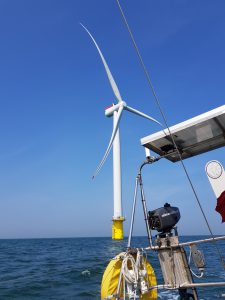Monday April 22nd 2019

Setting off to sail 350 miles from Lowestoft to Falmouth, you would think you could get away from the Extinction Rebellion people bringing central London to a standstill…
Don’t get me wrong, I’m all for saving the planet – also, I’d rather climate change didn’t start setting off unseasonal hurricanes.
But Global Warming and Greta Thunberg and the pink boat in Piccadilly Circus seemed to take over the whole voyage: Every time I picked up Radio 2 there were more arrests and when the 4G signal reappeared off St Catherine’s point, someone on the BBC website had calculated that in order to be carbon neutral by 2025, we are going to need another 130,000 wind turbines.
That’s right:130,000! Apparently, they will take up an area twice the size of Wales – except of course they won’t actually be in Wales, they’ll be offshore. Nobody minds offshore wind farms. After all, there’s nothing offshore is there? Just a lot of sea…
Well, yes – and that’s the problem.
Don’t get me wrong, I like wind turbines. There is something elegant them – the sails rotating in endless slow circles pumping out the kilowatts. They’re strangely beautiful – in a technological sort of way.
I just don’t want to have to get in among them – especially with the tide running and the wind dropping…
And they’re all over the place: I never knew about the Greater Gabbard Wind Farm. I am familiar with the Gunfleet Sands Wind Farm – although the Gunfleet Sands (2) was a surprise – as was Gunfleet (3) and, come to that, Gunfleet Demonstration Wind Farm.
The course did avoid the London Array and the Kentish Flats Wind Farms but that still left the Thanet Wind Farm which, being just off the top corner of Kent, is really inconvenient.
It was a relief, somehow, to dive into the traffic of the Dover Strait – at least the ferries get out of the way. But what a minute, what was this off Selsey? According to the chart, The Rampion Wind Farm is “under construction”. Oh no, it’s not. It’s up and running with some jazzy new turbines complete with, stylishly curved sails tipped off with red paint like a new airliner.)
I don’t want to be a Global Warming denier because that’s worse than being an offshore tax advisor or an MP and my predilection for sailing a small boat for my own pleasure doesn’t count for much when set against the survival of the planet – but is this going to be the end of sailing as we know it?
I’ve just looked at the map and discover that when I go and see my son at university in Liverpool next month, I will have to find my way either through or round the Rhyl Wind Farm and then the Gwynt-y-Mor Wind Farm – and that’s before I even get to the North Hoyle and the Burbo Bank Wind Farms…

